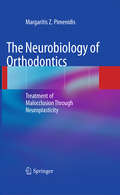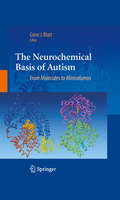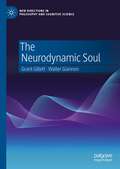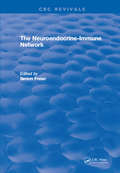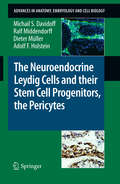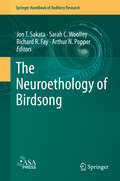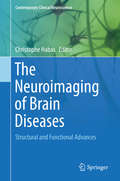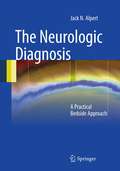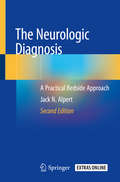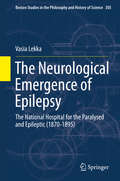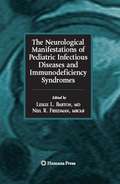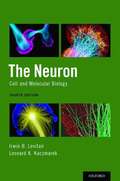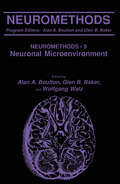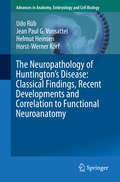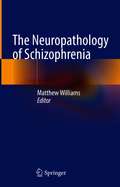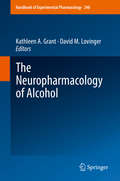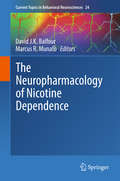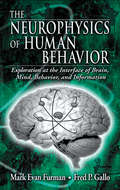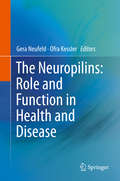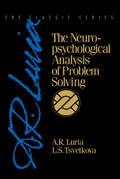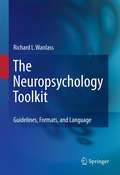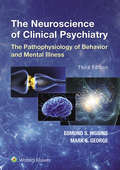- Table View
- List View
The Neurobiology of Orthodontics
by Margaritis Z. PimenidisThis book presents the neurobiology of orthodontics according to the most recently acquired knowledge on the interaction of the brain activity with the senses. In particular, it highlights the ability of orofacial sensory input to modulate and change the brain activity underlying functions of the stomatognathic system, such as chewing, biting, speech, and occlusal feedback. The approach adopted thereby represents a significant departure from traditional orthodontics, in which malocclusions of the teeth have been interpreted as deriving from DNA coding errors. The described new conceptualization of the etiology and diagnosis of malocclusions has profound implications for orthodontic therapy, as is clearly explained. Orthodontic therapy in turn has significant effects on the brain, which are documented in a chapter devoted to neuroimaging methods. By opening up new and creative pathways in the world of orthodontics, this book will hopefully both educate and excite the practitioner. It is recommended reading for all orthodontists.
The Neurochemical Basis of Autism
by Gene J. BlattThe Neurochemical Basis of Autism: From Molecules to Minicolumns is a uniquely interdisciplinary text that presents the latest findings regarding the physiological, neuropathological, neurochemical and clinical elements of autism. This book contains an array of unique perspectives on autism from top researchers, beginning with a clinical perspective that discusses etiologies, early identification, advancements in care and associated disorders. It then covers topics such as neuropathological changes in autism to the pre- and post-natal development timing of the disorder, changes in the cerebellum in autism, the role of oxytocin in autism, the relationship of oxidative stress and autism, and a comprehensive review of pharmacotherapies, as well as the hypotheses being used to explore its causes and cures. Lay abstracts make this book as accessible to the parents and caretakers of autistic children as it is indispensable to the scientists, researchers and clinicians on the front line of this affliction.
The Neurodynamic Soul (New Directions in Philosophy and Cognitive Science)
by Walter Glannon Grant GillettThis book is an analysis and discussion of the soul as a psychophysical process and its role in mental representation, meaning, understanding and agency. Grant Gillett and Walter Glannon combine contemporary neuroscience and philosophy to address fundamental issues about human existence and living and acting in the world. Based in part on Aristotle's hylomorphism and model of the psyche, their approach is informed by a neuroscientific model of the brain as a dynamic organ in which patterns of neural oscillation and synchronization are shaped by biological, social and cultural factors inside and outside of it. The authors provide a richer and more robust account of the soul, or mind, than other accounts by framing it in neuroscientific and philosophical terms that do not explain it away but explain it as something that is shaped by how it responds to the natural and social environment in enabling flexible and adaptive behavior.
The Neuroendocrine Immune Network
by S. FreierThis informative publication updates the study of interaction of the nervous and endocrine systems with the immune system in the body. It describes the anatomical basis of these interactions, reviewing the innervation of lymphoid tissue and mast cells. The book discusses the effect of the endocrine system on immune function, including the relation of sex to the immune response. Emphasis is given to opioids, substance P, neurotensin, vasoactive intestinal peptide, somatostatin and cholecystokinin. Also addressed is the immunoregulatory effect of leukotrienes and platelet-activating factors. Scrutinized within are stress as an aspect of neuro-immune interactions, and the central role of the hypothalamus in this context. The book reviews the eye and the gastrointestinal tract with respect to the coordination of the nervous, endocrine, and immune systems in serving these organs. This work is of particular value to those in immunology, endocrinology, gastroenterology, and developmental biology.
The Neuroendocrine Leydig Cells and their Stem Cell Progenitors, the Pericytes
by Adolf F. Holstein Ralf Middendorff Michail S. Davidoff D. MüllerThe discovery of the neuroendocrine features of Leydig cells gave rise to the hypothesis of a potential neuroectodermal and/or neural crest origin of testicular Leydig cells. In an experimental animal model the authors revealed that adult Leydig cells originate by transdifferentiation from stem/progenitor cells (pericytes and smooth muscle cells), underlying the close relationship of Leydig cells with testis microvasculature. This and the supporting data from the literature provided the basis for revealing the pericytes as a common adult stem cell type of mammalian species. Distributed by the microvasculature through the entire body, the pericyte, acting as a resting early pluripotent adult stem cell, provides an ingenious system to assure the maintenance, physiological repair and regeneration of organs, each under the influence of specific local environmental factors.
The Neuroethology of Birdsong (Springer Handbook of Auditory Research #71)
by Arthur N. Popper Richard R. Fay Jon T. Sakata Sarah C. WoolleyVocal signals are central for social communication across a wide range of vertebrate species; consequently, it is critical to understand the mechanisms underlying the learning, control, and evolution of vocal communication. Songbirds are at the forefront of research into such neural mechanisms. Indeed, songbirds provide a particularly important model system for this endeavor because of the many parallels between birdsong and human speech. Specifically, (1) songbirds are one of the few vertebrate species that, like humans, learn their vocal signals during development, (2) the processes of song learning and control in songbirds shares many parallels with the process of speech acquisition in humans, and (3) there exist deep homologies between the circuits for the learning, control, and processing of vocal signals across songbirds and humans. In addition, because of the diversity of songbirds and song learning strategies, songbirds offer a powerful model system to use the comparative method to reveal mechanisms underlying the evolution of song learning and production. Taken together, research on songbirds can not only reveal general principles underlying vertebrate vocal communication but can also provide insight into potential mechanisms underlying the learning, control, and processing of speech. This volume will cover a range of topics in birdsong spanning multiple level of analysis. Chapters will be authored by the world’s leading experts on birdsong and will provide comprehensive reviews of the processes underlying song learning, of the neural circuits for song learning and control as well as for the extraction and processing of song information, of the selection pressures underlying song evolution, and of genetic and molecular mechanisms underlying the learning and evolution of song. The primary goals of this volume are to provide comprehensive, integrative, and comparative perspectives on birdsong and to underscore the importance of birdsong to biomedical research, evolutionary biology, and behavioral, systems, and computational neuroscience.The target audience of this volume will be graduate students, postdoctoral fellows, and established academics and neuroscientists who are interested in mechanisms of communication from an integrative and comparative perspective. The volume is intended to function as a high-profile and contemporary reference on current work related to the learning, control, processing, and evolution of birdsong. This volume will have broad appeal to comparative and sensory biologists, neurophysiologists, and behavioral, systems, and cognitive neuroscientists who attend meetings such as the Society for Neuroscience, the International Society for Neuroethology, and the Society for Integrative and Comparative Biology. Because of the relevance of birdsong research to understanding human speech, it is likely that the volume will also be of interest to speech researchers and clinicians researching communication, motor, and sensory processing disorders.
The Neuroimaging of Brain Diseases: Structural and Functional Advances (Contemporary Clinical Neuroscience)
by Christophe HabasNotable experts in the field of neuroimaging provide comprehensive overviews of advances in functional and structural aspects of both common and uncommon brain disorders. Functional imaging is evolving quickly but researchers and clinicians do not always have a strong understanding of the fundamental basis of the imaging techniques that they use. By focusing on both structure and function this book will provide a strong foundation for emerging developments in the field.
The Neurologic Diagnosis
by Jack N. AlpertThe Neurologic Diagnosis: A Practical Bedside Approach is an introductory text that simplifies the often unwieldy method of making a neurologic diagnosis. Medical students are often intimidated by a deluge of data, extensive differential diagnoses, and have no organizational structure to follow. Diagnostic techniques of general medicine are not applicable. Neurology is a unique specialty since it requires the intermediary step of an anatomic diagnosis prior to proffering a differential diagnosis. Yet the required knowledge of neuroanatomy need not be profound for the student who will specialize in any field other than neurology and neurosurgery. This text is directed to medical students and residents who will all be regularly faced with numerous patients who have neurologic symptomatology. Typical one-month neurology rotations out of four years of medical school is clearly inadequate training to make a cogent neurologic diagnosis, especially since subsequent instruction is commonly provided by upper level residents who have the same background and numerous misconceptions. This is not a comprehensive text. The emphasis in this concise and practical title is on establishing a neuroanatomic diagnosis before formulating a differential diagnosis. In addition, treatment is seldom discussed since it is likely to change radically over time. Focused and succinct, The Neurologic Diagnosis: A Practical Bedside Approach is an invaluable resource for medical students and residents interested in the practice of neurological diagnosis.
The Neurologic Diagnosis: A Practical Bedside Approach
by Jack N. AlpertAn introductory text that transitions into a moderately advanced, case-based analysis of neurologic disorders and diseases, this book emphasizes how to simplify the process of making a neurologic diagnosis. Medical students and residents are often intimidated by a deluge of data, perception of anatomic complexity, extensive differential diagnoses, and often have no organized structure to follow. Diagnostic methods of general medicine are not applicable. Indeed, neurology is a unique specialty since it requires the intermediary step of an anatomic diagnosis prior to proffering a differential diagnosis. Yet the required knowledge of neuroanatomy need not be profound for the student or resident who will not specialize in neurology or neurosurgery. The Neurologic Diagnosis: A Practical Bedside Approach, 2nd Edition is primarily directed to neurology and neurosurgery residents but it will be useful for medical and family practice residents who will discover that a great percentage of their patients have neurologic symptoms. A one-month neurology rotation out of four years of medical school is not sufficient to make a cogent neurologic diagnosis. The aim of this concise, practical book -- which includes an in-depth video of how to perform a neurologic examination -- is to facilitate the process of establishing a neuroanatomic diagnosis followed by a rigorous analysis of symptoms and signs to reach a well-thought out differential diagnosis. Focused and succinct, this book is an invaluable resource for making a lucid neurologic diagnosis.
The Neurological Emergence of Epilepsy
by Vasia LekkaThis book explores the emergence of epilepsy as a purely neurological disorder, in the second half of the nineteenth century. It focuses on the world's first neurological hospital, the National Hospital for the Paralysed and Epileptic in London, and on its leading figure, John Hughlings Jackson (1835-1911). Through an analysis of the National Hospital's medical records and a historical account of the course of epilepsy until our time, this book presents the nineteenth-century turn towards the scientific study of the human brain and the various political, social, ideological and epistemological implications of this major change. In spite of the recent trend of describing the history of mental illness, mental patients and psychiatric institutions, so far, neurology, epilepsy and epileptic patients have largely remained outside the scope of social historians, historians of medicine and social scientists. This book has the ambition to fill that gap.
The Neurological Manifestations of Pediatric Infectious Diseases and Immunodeficiency Syndromes
by J. J. Volpe Leslie L. Barton Neil R. FriedmanIn this concise book, an international panel of experts provide a succinct, up-to-date, evidence-based reference to the neurological consequences of infectious diseases and immunodeficiency syndromes in children in one readily accessible volume. Within each of its conveniently structured chapters, readers will find a general description of the disease or disorder. Finally a volume for pediatricians, neurologists, infectious disease specialists and all who care for children.
The Neuron: Cell And Molecular Biology
by Leonard K. Kaczmarek Irwin B. LevitanThe Fourth Edition of The Neuron provides a comprehensive first course in the cell and molecular biology of nerve cells. <p><p>The book begins with properties of the many newly discovered ion channels that have emerged through mapping of the genome. These channels shape the way a single neuron generates varied patterns of electrical activity. Covered next are the molecular mechanisms that convert electrical activity into the secretion of neurotransmitter hormones at synaptic junctions between neurons. The following section examines the biochemical pathways that are linked to the action of neurotransmitters and that can alter the cellular properties of neurons or sensory cells that transduce information from the outside world into the electrical code used by neurons. The final section reviews our rapidly expanding knowledge of the molecular factors that induce an undifferentiated cell to become a neuron, and then guide it to form appropriate synaptic connections with its partners. This section also focuses on the role of ongoing experience and activity in shaping these connections, and finishes with an account of mechanisms thought to underlie the phenomena of learning and memory. <p><p>The book contains scores of color figures and fully updated chapters; online content packaged exclusively with the Fourth Edition includes detailed animations of neural processes, in-depth supplemental reading, and additional full-color figures and tables.
The Neuronal Microenvironment
by Alan A. Boulton Wolfgang Walz Glen B. BakerThe Neuronal Microenvironment
The Neuropathology of Huntington's Disease: Classical Findings, Recent Developments and Correlation to Functional Neuroanatomy
by Udo Rüb Jean Paul G. Vonsattel Helmut Heinsen Horst-Werner KorfThis monograph describes the progress in neuropathological HD research made during the last century, the neuropathological hallmarks of HD and their pathogenic relevance. Starting with the initial descriptions of the progressive degeneration of the striatum as one of the key events in HD, the worldwide practiced Vonsattel HD grading system of striatal neurodegeneration will be outlined. Correlating neuropathological data with results on the functional neuroanatomy of the human brain, subsequent chapters will highlight recent HD findings: the neuronal loss in the cerebral neo-and allocortex, the neurodegeneration of select thalamic nuclei, the affection of the cerebellar cortex and nuclei, the involvement of select brainstem nuclei, as well as the pathophysiological relevance of these pathologies for the clinical picture of HD. Finally, the potential pathophysiological role of neuronal huntingtin aggregations and the most important and enduring challenges of neuropathological HD research are discussed.
The Neuropathology of Schizophrenia
by Matthew WilliamsIn the past few decades, neuropathology has witnessed a resurgence. The rise of structural and functional imaging techniques has allowed pathological studies to target regions of special interest as revealed by whole-brain techniques, and the development of comprehensive software packages has facilitated cellular and pathological measurements. Furthermore, a new generation of antibodies and improved staining methods has made the field more accessible to researchers and revealed more detail than could once have been envisaged. Perhaps most important of all has been the sourcing of high-quality tissue through modern, large-scale databases covering multiple tissue banks, removing much of the heterogeneity that had made repeat studies all but impossible. The Neuropathology of Schizophrenia reviews the field following these recent improvements in techniques and contrasting more modern methods against older studies. This book presents the current state of neuropathological knowledge in schizophrenia by means of examination of neuropathology as informed by functional systems. It starts by considering the frontal cortical region, a particularly well-examined region of the brain, before moving through other cortical regions, subcortical pathways and the deep white matter. In addition, potential new routes for investigation are considered, particularly in glial cells.
The Neuropharmacology of Alcohol (Handbook of Experimental Pharmacology #248)
by Kathleen A. Grant David M. LovingerThis volume gives an overview of new insights to alcohol pharmacology using DREADDs (Designer Receptors and Unraveling the Neuropharmacology of Alcohol). It examines which pharmacological principles should be applied to understanding DREADDs taking into account some very current research. Additionally, this book covers important topics under the heading of “experimental pharmacology” and alcohol.
The Neuropharmacology of Nicotine Dependence
by David J.K. Balfour Marcus R. MunafòThe primary purpose of this book and its companion volume The Behavioral Genetics of Nicotine and Tobacco is to explore the ways in which recent studies on nicotine and its role in tobacco addiction have opened our eyes to the psychopharmacological properties of this unique and fascinating drug. While The Behavioral Genetics of Nicotine and Tobacco considers the molecular and genetic factors which influence behavioral responses to nicotine and how these may impact on the role of nicotine in tobacco dependence, the present book focuses on the complex neural and psychological mechanisms that mediate nicotine dependence in experimental animal models and their relationship to tobacco addiction in humans. These volumes will provide readers a contemporary overview of current research on nicotine psychopharmacology and its role in tobacco dependence from leaders in this field of researchand will hopefully prove valuable to those who are developing their own research programmes in this important topic.
The Neurophysics of Human Behavior: Explorations at the Interface of Brain, Mind, Behavior, and Information
by Fred P. Gallo Mark E. FurmanHow do brain, mind, matter, and energy interact? Can we create a comprehensive model of the mind and brain, their interactions, and their influences? Synthesizing research from neuroscience, physics, biology, systems science, information science, psychology, and the cognitive sciences, The Neurophysics of Human Behavior advances a unified theory of
The Neurophysiological Bases of Auditory Perception
by Ray Meddis Enrique Lopez-Poveda Alan R. PalmerThe International Symposium on Hearing is a triennial, highly-prestigious event where world-class scientists present and discuss the most recent advances in the field of hearing research. The symposium focuses on the relationship between auditory physiology, psychoacoustics, and computational modeling. Presented papers range from basic to applied research, and are published in book format. The books from past editions have a large demand by neuroscientists, otolaryngologists, psychologists, and artificial intelligence researchers. This meeting is highly special in that every paper is a plenary session given by invitation by a key, world-class auditory scientist. There are no poster sessions. The editors will have to choose the best 60 papers from approximately 80 submitted abstracts. Priority will be given to hot topics and to papers showing significant advances (this is almost guaranteed, anyhow, by the quality of the speakers). Papers will be submitted by invitation only and invitations will be sent only to the most-significant auditory scientists at present. Furthermore, published papers can be regarded as peer-reviewed because they will be accompanied (in print) by a full discussion between the authors and other conference attendants. This format is identical to that of preceding editions of this symposium and has proven highly successful. A full list of past conference books is given below. We will not know the list of chapters until approximately November 2008, that is 6 months before the conference (May 2009). You can get an idea of the type and format of the chapters by having a look at the books for the last two symposium editions, which were published by Springer.
The Neuropilins: Role and Function in Health and Disease
by Gera Neufeld Ofra KesslerThis book covers basic research topics such as the structure-function relationships of neuropilins and mechanisms of neuropilin-mediated signal transduction, details the most important roles of the neuropilins in developmental biology, and addresses their roles in various conditions such as cancer and various eye diseases. The two neuropilin genes encode scaffold receptors that can bind several different ligands, and also associate with many other receptors and modify their activity. Further, it has been confirmed that they play important roles in the shaping of major organs and tissues such as the nervous system and the vascular system, and that they can modulate immune responses. The book offers a helpful guide for biomedical researchers and all scientists active in the neurosciences, vascular and molecular biology, as well as developmental biology and immunology.
The Neuropsychiatry of Epilepsy
by Bettina Schmitz Michael R. TrimbleResearch into the neuropsychiatry of epilepsy has become a central focus of interest in the last five years. Comorbidity of epilepsy with behavioral problems is now recognized widely, and the neuroscientific basis for such comorbidity is an active area of investigation. With an expanded international team of authors, this fully revised new edition builds on the strengths of its predecessor, examining in detail the subtleties of behavioral changes in patients with seizure disorders and offering both a diagnostic and a management perspective. New chapters cover genetic disorders, the effects of epilepsy on social behavior as viewed through theory of mind, a discussion of the precuneus, the importance and nature of peri-ictal psychiatric symptoms, depression and the interictal dysphoric disorder, and the relationship between antiepileptic drugs and suicide. This new edition is a must for anyone involved in diagnosing or managing epilepsy.
The Neuropsychiatry of Headache
by Mark W. Green Philip R. MuskinWhilst the vast majority of headaches are minor ailments, some patients develop chronic symptoms that have psychiatric dimensions. These symptoms can be immensely challenging to manage and can have a serious impact on the patient's quality of life. The relationship between headache and psychiatric disease is often rationalized as cause and effect; however, the interplay between the two is complex. Management of each of the co-morbid disorders affects the other one in positive and/or negative ways. The Neuropsychiatry of Headache details the current concepts of various headache conditions and the psychiatric syndromes; topics covered include migraine, mood disorders, medication overuse and personality disorders. Headache specialists, neurologists, psychiatrists, neuropsychiatrists and neuropsychologists will find this an invaluable resource for understanding and co-managing these conditions.
The Neuropsychological Analysis of Problem Solving
by LuriaFor any of us, problem solving is a daily event. For some, it is a major task. This historical book puts to use neuropsychological methods to analyze the process of problem solving. Experience shows that the process is psychologically so complicated that standard methods established in pedagogy and psychology are insufficient to precisely determine individual factors hindering effective problem solving.The authors present techniques for rehabilitation training which could compensate for the impairments observed in individual cases. Luria's work has transformed rehabilitation training, enabling the evaluation of rehabilitation principles and methods.Luria's thinking and conceptual style reflect his genius and rich understanding of brain-behavior relationships. As those who have read it agree, Luria demonstrates remarkable insight with his complex analysis and his qualitative analysis is ""breathtaking.
The Neuropsychology Toolkit
by Richard L. WanlassThis book provides information, guidelines, and materials to help future neuropsychology supervisees identify, understand, and avoid some of these problems and pitfalls. Also included are a neuropsychological questionnaire, short- and long-report formats, and sample statements that can be used to help with wording sections of the report that are particularly challenging to write.
The Neuroscience of Clinical Psychiatry: The Pathophysiology Of Behavior And Mental Illness
by Edmund HigginsBridge the gap between neuroscience and mental illness/mental health with this straightforward and reader-friendly resource! The Neuroscience of Clinical Psychiatry, 3rd Edition is a highly readable, in-depth text ideal for residents studying for boards, practicing psychiatrists, and any mental health professional seeking an overview of the neuroscience revolution. Focusing on the basic neuroscientific concepts underlying normal behavior and commonly encountered disorders, Dr. Edmund S. Higgins and Dr. Mark S. George make complex information enjoyable, relevant, and easy to understand, ensuring that this Third Edition continues to be a trusted source of information on the neurologic underpinnings of psychiatric disorders.
